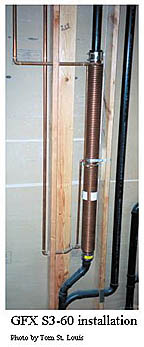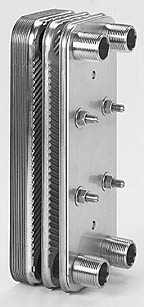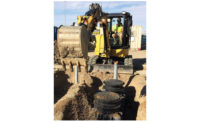An increasing amount of attention is being given to the important role heat exchangers perform in many applications. Heat exchangers have been used in commercial and industrial applications for some time; however, there are many heat streams overlooked, including the huge amount of energy being wasted through the drain plumbing systems. Can we afford to continue to let this energy slip away? Heat can easily be transferred from where it is wasted to where it can be made useful.
The process of heat transfer through fluid-to-fluid heat exchangers is based on basic properties of heat conduction. When two independent chambers or circuits carrying fluids with a temperature difference are touching, the heat always moves to cold, trying to find equilibrium. Two important factors in the effectiveness of heat transfer are the amount of surface area that comes in contact with the heat source and the materials used to conduct the heat.
Over the past decade, advancing heat exchanger technologies have been penetrating the U.S. market. Paralleling the advances in technology are an increasing interest in the cost benefits of efficient use of energy resources, as well as other concerns about resource management. The efficient management of heat resources already available within our plumbing and mechanical systems is an effort to turn a "waste stream" into a "resource stream" or commodity.
This article will explore two types of heat exchangers that are now being used in various applications to efficiently transfer heat and provide significant energy savings. These two systems focus on distinctly different markets. The tube and coil Gravity Film eXchanger (GFX) system is installed on the drain line of a plumbing system in order to extract heat from draining wastewater, no matter how dirty it is. Plate Heat Exchangers (PHEs) use small passages and great surface area to maximize heat transfer, and are for use with fluids without prohibitive particulates or residue build-up in applications within hydronic, refrigeration, industrial, and original equipment manufacturer markets.

Gravity Film eXchanger (GFX)
Gravity Film eXchanger (GFX) is a tube and coil drain heat recovery (DHR) system that works as a simple plumbing device. This well-engineered plumbing device transfers heat from drainwater to preheat incoming cold water through a copper supply line mechanically wrapped in a coil around a copper DWV pipe/tube. The key to the effective heat transfer is the large amount of copper surface area in contact with the thin, falling film of drain water. When wastewater drains through a vertical pipe, it does not fall down the center. Instead the water clings to the inner surface of the DWV pipe as it displaces the air in the pipe, taking the path of least resistance and obeying natural properties of surface tension. The water travels down the inner pipe walls in a thin, turbulent film that allows efficient heat transfer through the pipe wall. This falling film system will not work in the horizontal position; it must be vertical to distribute the hot fluid over a large surface area of copper drainpipe.Plate Heat Exchangers
A Plate Heat Exchanger, or PHE, is constructed of a series of flat plates that are either stamped or embossed with channels. "The plates are stacked so they form a multi-layered alternating path for each fluid to travel through; each layer or circuit is linked to an inlet and outlet via a manifold at either end. The design of a PHE maximizes surface area to provide greater heat dissipation."(1) PHEs are categorized in two general ways dependent on how they are constructed--either Brazed Plate or Plate and Frame. Generally constructed of stainless steel, these units resist corrosion. They are cost effective and compact in size due to their great amount of surface area.(1)
Even though the two systems use the same properties of heat conduction, they are quite different in shape and in application. Following are details on the construction and some of the applications of each.
Tube and Coil Drain Heat Recovery
Drain Heat Recovery (DHR) is the capture of energy contained in drainwater that would otherwise be lost into the sewer system. Common sources include showers, sinks, clothes washers, dishwashers, and many other locations. The U.S. Department of Energy's Energy Information Administration (EIA) estimated that in 1995, residential water heaters consumed 740 billion kWh of energy, and commercial water heaters consumed 320 billion kWh. Approximately 80-90% of this energy goes down the drain, carrying with it billions of kWh and billions of dollars. Efforts to recover this energy, such as the tube and coil GFX system, can result in significant energy savings.
As hot water goes down the drain, the GFX efficiently transfers the heat through the walls of the copper drain line to the cold water as it simultaneously flows up through the supply coil. Depending on the amount of use and the size of the system, 50-85% of the drain heat can be transferred to the cold supply water through the copper without contamination. The heat recovery significantly preheats the incoming water, thereby reducing the work of water heaters and greatly reducing the amount of energy/money spent to heat water.
Construction
Two standard plumbing components make up the Gravity Film eXchanger (GFX) units. They are type L copper water supply tubing and copper Drain Waste Vent (DWV) pipe. The supply tubing is mechanically attached by tightly coiling it around the DWV pipe. This construction maintains the UPC-listed parts in the product, making it double walled with leak detection, vented through the atmosphere. The double-wall vented construction in GFX drain heat recovery systems is necessary to ensure public safety by preventing cross-contamination, and it is mandatory in food processing applications and most residential plumbing codes. The copper material used is economical, as well as being an excellent conductor of heat. The unique, non-welded construction is easy to install and maintain.
The GFX is constructed in a large variety of sizes with additional options for customization. Lengths of 2", 3", and 4" are the most common sizes for the DWV pipe and 5/8" and 7/8" OD (Outside Diameter) are the common sizes for supply tubing. Unit lengths typically range from 20" to 80". Manifolded units are commonly used for commercial applications. The variety and versatility of GFX systems can fit the designer and engineer's imagination.
Applications
GFX as a heat exchange system can be used wherever sufficient temperature difference exists between fluids. There are many drain heat recovery applications in residential, commercial and industrial situations. Some of these are:
- Single family homes, apartment buildings, and multi-family developments.
- Hotels, hospitals, dormitories, and senior living facilities.
- Prisons and military facilities.
- Gyms and public showers.
- Beauty salons and laundries.
- Commercial kitchens, restaurants, food processors, etc.
- Cooling-walls, manufacturing, and process fluids in industrial applications.
The plumbing systems of such locations have the perfect mix of waste heat and demand for hot water to justify using GFX systems for preheating water.
The GFX is a counter-flow heat exchanger. In its most common application it is installed vertically as a section plumbing drain line. The cold supply line goes into the bottom of the GFX outer coil, and then the top of the coil is connected to the incoming cold water line just before the water heater, directly to the cold side of the shower fixture, or to both. The GFX recovers heat if the warm wastewater is flowing at the same time as the cold supply water. This is easy for showers and sinks; however, to recover heat from batch processes such as bathtubs, clothes washers and dishwashers there must be a second demand for cold water supply occurring as the batch is draining or shortly after. This can easily be done with a little effort in residential situations, and with some synchronization in commercial applications.
The typical household percentage of hot water sent down the drain from showers and running faucets is about 57%, based upon a published study from Lawrence Berkeley Laboratory.(2) DHR efficiency of 60% is cost-effective in many homes; corresponding to a 34% reduction in domestic hot water energy. This figure was used in a comprehensive study entitled, "Electric Water Heating Situation Analysis," by A.D. Little, Inc. for the Edison Electric Institute and the U.S. Department of Energy.(3)
DHR Tax Credits, Rebates and Studies
On January 1, 2000, Oregon became the first state to promote DHR with residential and commercial tax credits (www.energy.state.or.us/res/tax/apphtrec.htm). In 1999, Minnesota power became the first utility to offer a rebate for DHR systems. Madison Gas & Electric became the first utility to add DHR to a HUD Rehabilitation Project in Madison, WI. A recent field evaluation of the GFX conducted by Pennsylvania Power and Light found the simple payback of a residential GFX system to range from two to five years. This was based on an installed GFX cost of $500 and electricity savings ranging from 800 kWh/year to 2,300 kWh/year, depending on the daily average number of showers in each home. The economics of the GFX improved with the number of daily showers in the residence. In general, buildings that require large amounts of hot water for showers would be ideal candidates for the GFX and would lead to shorter paybacks.Example: Figuring the potential energy in shower drain water per 12-minute shower, here is the calculation:
Q = F x (To-Ti) x 8.34 x 12
Where:
Q = power available from shower drain water in Btu per shower (Btu/Shr)
F = flow rate down the drain in gallons per minute (gpm)
To = temperature of the drain water out (degrees F)
Ti = temperature of cold supply water (degrees F)
8.34 = the heat capacity of water in Btu per gallon per degrees F temperature difference (Btu/gal-degrees F)
12 = the national average minutes per shower
For a 3.0 gpm shower with 95 degrees F drain water (a 105 degrees F shower cooling to 95 degrees F on the way to the drain) and 50 degrees F cold water supply:
Q = 3.0 x (95 - 50) x 8.34 x 12
= 13,500 Btu per shower or 3.96 kilowatts
With 60% recovery efficiency, the GFX can recover 8,106 Btu or 2.38 kW per shower and deliver that energy to the water heater or directly to the cold side of the shower fixture. That 2.38 kW is enough energy to run more than 200 11-watt compact florescent light bulbs for an hour.
Case Study
202 GFX heat exchangers are being installed into Troutdale Terrace, a large apartment complex located in Troutdale, OR. The development project is aimed at providing affordable housing with affordable utilities. The project is receiving Oregon State tax incentives for energy efficiency. The GFX (Gravity Film eXchanger) is a simple plumbing device that replaces a section of vertical drainpipe with an all copper heat exchanger. The heat exchangers consist of 2" and 3" diameter by 60" lengths of copper drainpipe with half-inch tubing coiled tightly around them. As hot water is used, it goes down the drain, clinging to the inside surface as a thin film that efficiently transfers the heat through the copper drain line to the cold water as it simultaneously flows up through the GFX coils. Between 50-85% of the heat can be transferred to the cold supply water through the copper without contamination. The heat transfer significantly preheats the incoming water, thereby reducing the work of the water heaters and cutting the amount of energy/money spent to heat the water.With 55% of the heat transferred from 96-degree drain water into 45-degree cold supply water, a full sized 60" GFX can save Troutdale Terrace residents 2.06 kWh per 12-minute shower. If electricity costs $.11 per kWh, $.23 can be saved every shower. Assuming 404 people take showers every day, the potential savings is $2,826.32 a month, or $33,915.80 a year, for the 202 GFXs. The avoided energy costs means the system will pay for itself in two to three years.
Troutdale Terrace is being developed by Winkler Development, Co., and designed by Sullivan Architecture, LLC. The general contractor is R+H Construction Co. and the plumbing contractor is Tapani Plumbing, Inc. The Troutdale Terrace apartment project is the largest in a series of installations of GFX drain heat recovery. Some of the other recent installations have been for flight-type commercial dishwashers, commercial laundry facilities, gyms, salons, and single-family residences, to name a few. GFX is manufactured by Doucette Industries and can be viewed at www.endlessshower.com and www.GFXtechnology.com.

Plate Heat Exchangers (PHEs)
Plate Heat Exchanger technology has been around for about 60 years. PHEs have been used in a variety of applications. As the technology has advanced and been refined, people and companies have begun looking at the potential uses in a new light. Brazed Plate Heat Exchangers are a more recent evolution of the older Plate and Frame Heat Exchanger.Construction
The most common plate material is stainless steel. Titanium and other hybrid metals are used in some applications. There are two independent circuits in the PHE. One is used for the fluid to be cooled or heated, the other circuit for the source fluid. "The plates are stacked so they form a multi-layered alternating path for each fluid to travel through. Each layer or circuit is linked to an inlet and outlet via a manifold at either end."(1)A Plate and Frame system is a series of such plates held together with two sturdy outside frames. Gaskets are used between each plate in order to seal them. Long bolts compress the plates and the gaskets together between the frames. This type of system can be can be changed as the needs change. The Plate and Frame system can also be taken apart for periodic cleaning and maintenance. This is necessary when the fluid being used is known to leave a deposit buildup.(1)
The Brazed Plate system does not contain gaskets or require the frame and bolts to hold it together. The plates are held together with high temperature brazing. "The embossed plates are assembled in the desired configuration with layers of copper or nickel brazing"(1) between each; then the units are placed in a furnace and heated to activate the brazing process. The design of the Brazed Plate Heat Exchanger maximizes the surface area and fluid turbulence to provide more heat transfer. Brazed plate systems can be pre-made and stocked for many standard applications. They are made in a large range of sizes. Some of the advantages of the Brazed Plate system are their low cost, high efficiency, ease of installation, permanent construction and fast delivery.(1)
Applications
PHEs have many applications for the removal of heat (i.e. condensers in a refrigerant circuit). They also have applications in providing heat. PHEs are being widely used in the refrigeration, hydronic heating, industrial and OEM (originalequipment manufacture) markets.(4) PHEs are not used for drain heat recovery because of the large amount of particulates and build-up residue in wastewater.Some PHE refrigeration components are fluid chillers, condensers, evaporators, cascade condensers, sub-coolers, economizers, compressor oil coolers and air dryers.(4)
Brazed Plate Heat Exchangers are used in a wide variety of refrigeration, air conditioning and special purpose markets. These include:
- Swimming pool heating/cooling
- Beverage and beer cooling
- Hydrocarbon processing
- Hydraulic oil cooling
- Compressed air drying
- Environmental chambers
- Ice making machines
- Supermarket systems
- Various glycol coolers
- Many types of water chillers(4)
PHEs are used in a wide variety of hydronics applications. Some are:
- Domestic hot water
- Radiant floor
- Snowmelt
- Spas and swimming pools
- Fuel oil pre-heater
- Condensate and make-up water
- Shell and tube replacement
- Boiler systems
- Steam systems
- Process heating(4)
There are literally hundreds of possibilities for PHEs in industrial, process and manufacturing applications--wherever there are sufficient temperature differences in fluids.
Conclusion
Conduction and other types of heat transfer are present and ongoing all the time; like a hot drink warming your hands on a cold morning, that luxurious steamy shower warming the sewer pipes, or managing and conserving heat in a building's plumbing and mechanical systems with heat exchangers. Understanding that heat exchangers can be utilized in many ways will help to maximize the use and recovery of heat energy. This energy is becoming too costly to waste. Building technologies are evolving to prevent warm air from being lost, so why continue to needlessly waste energy down the drain?
Special thanks to Dr. Carmine Vacile, Tom St. Louis, and Steve Wand.

